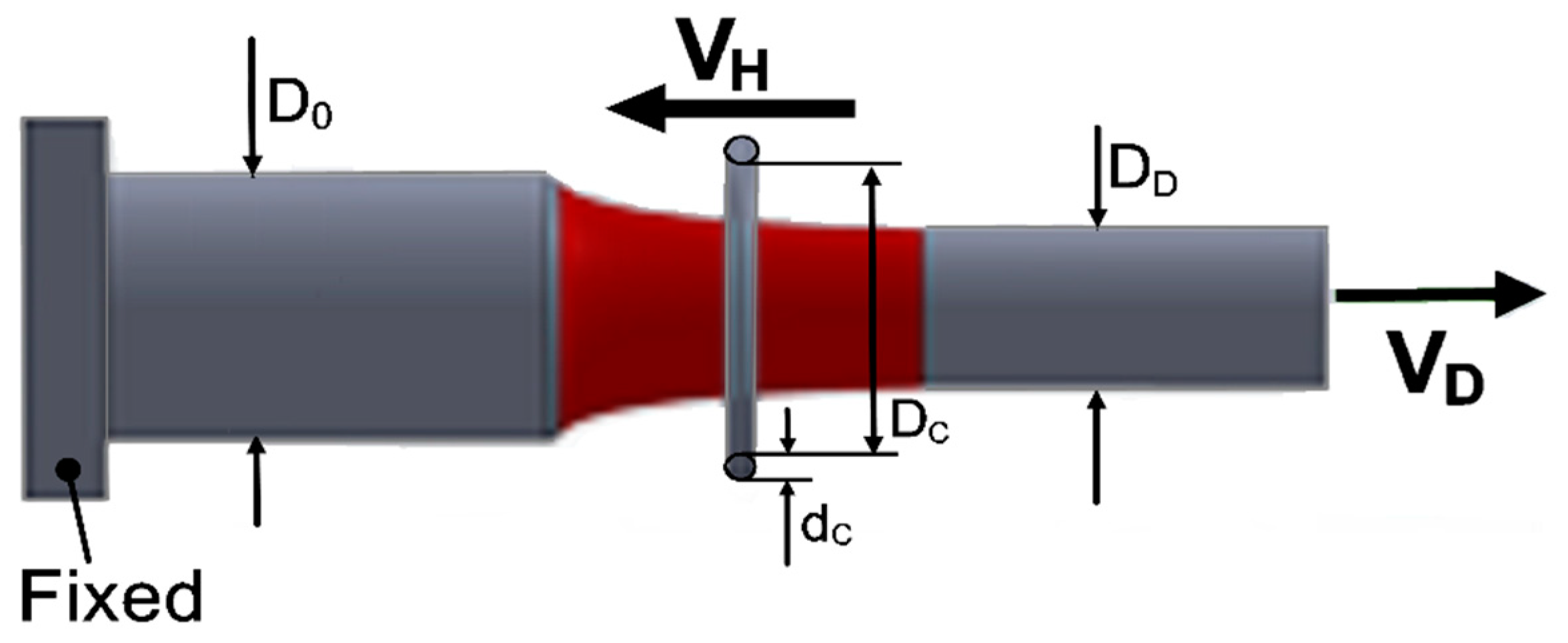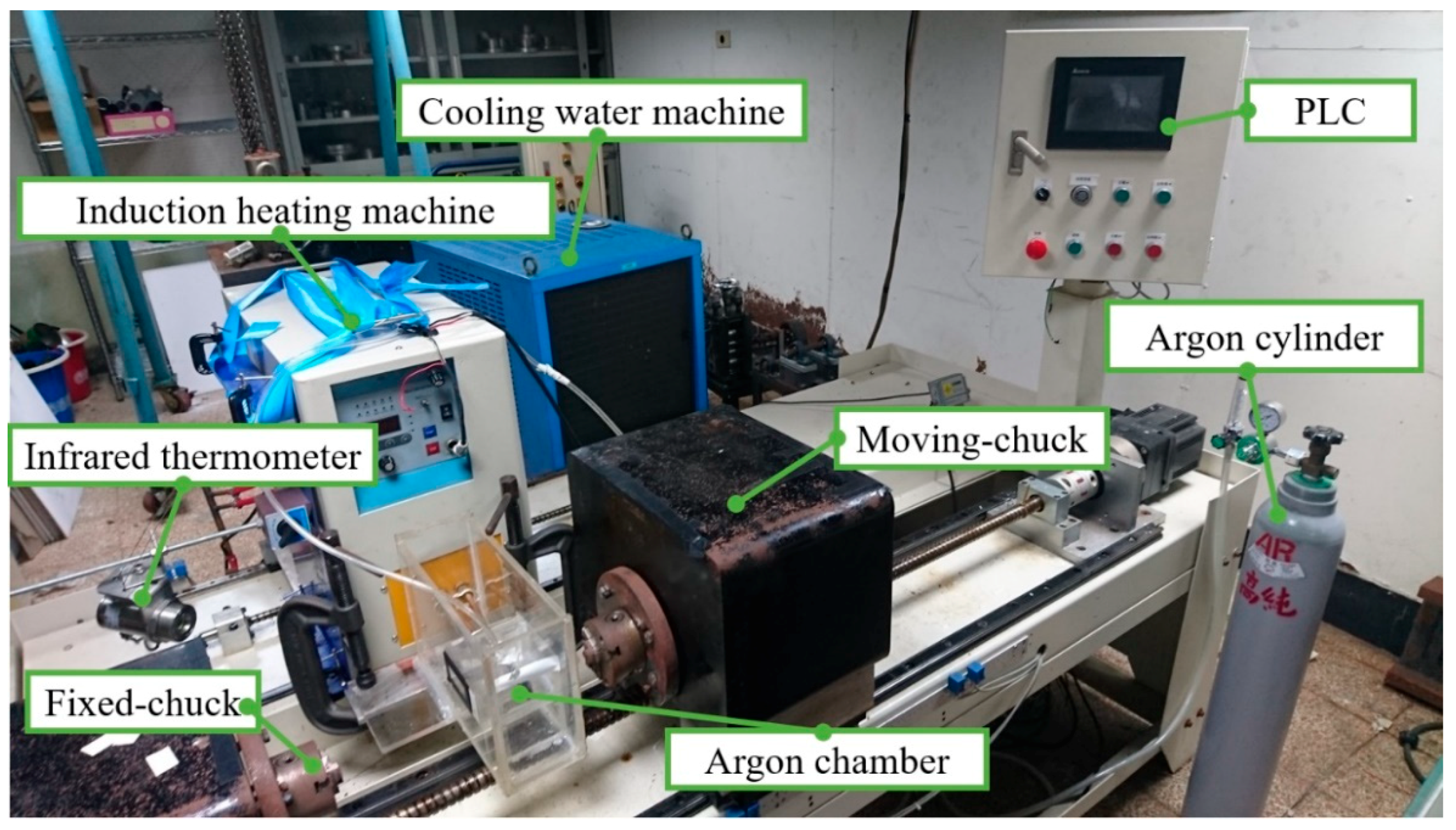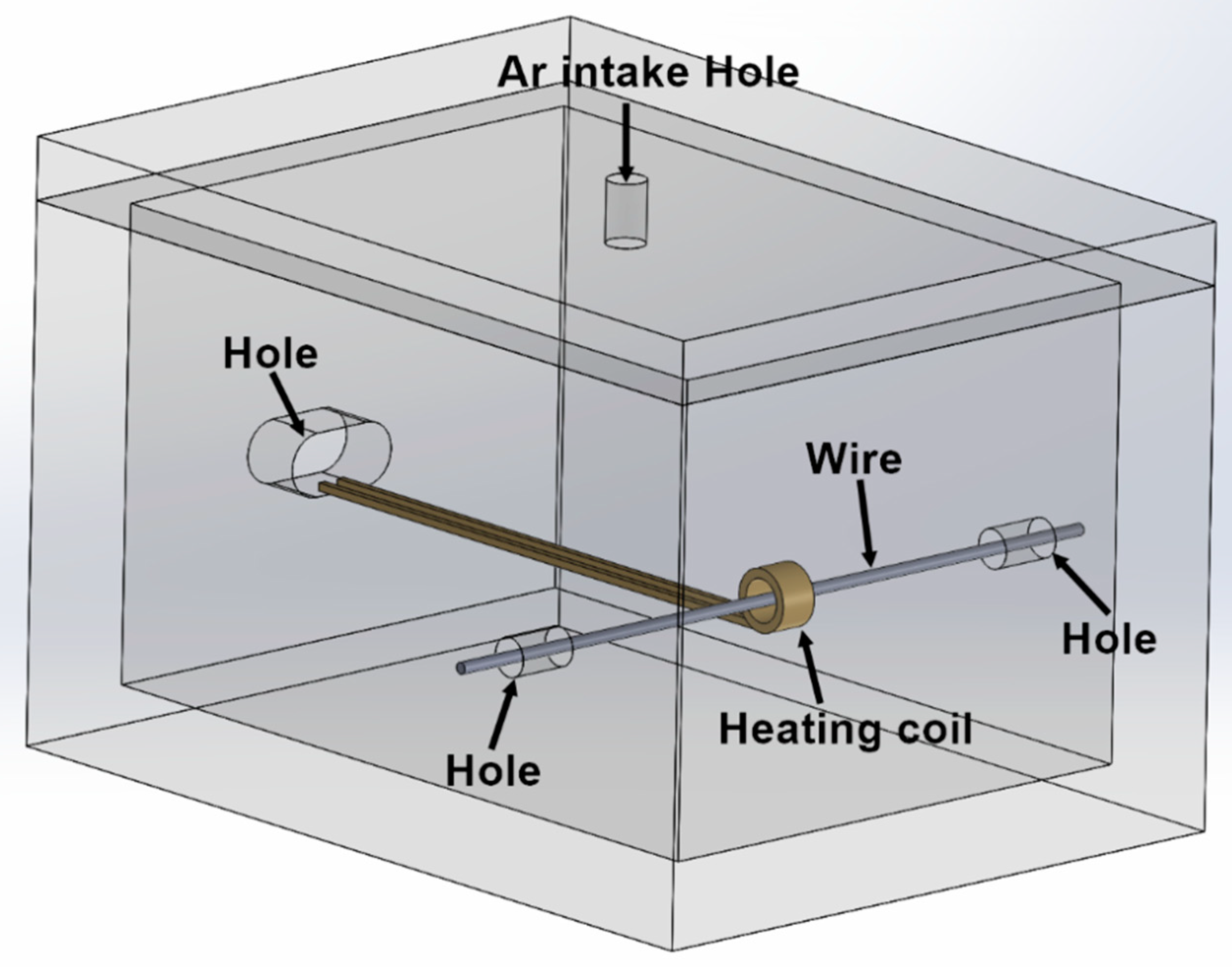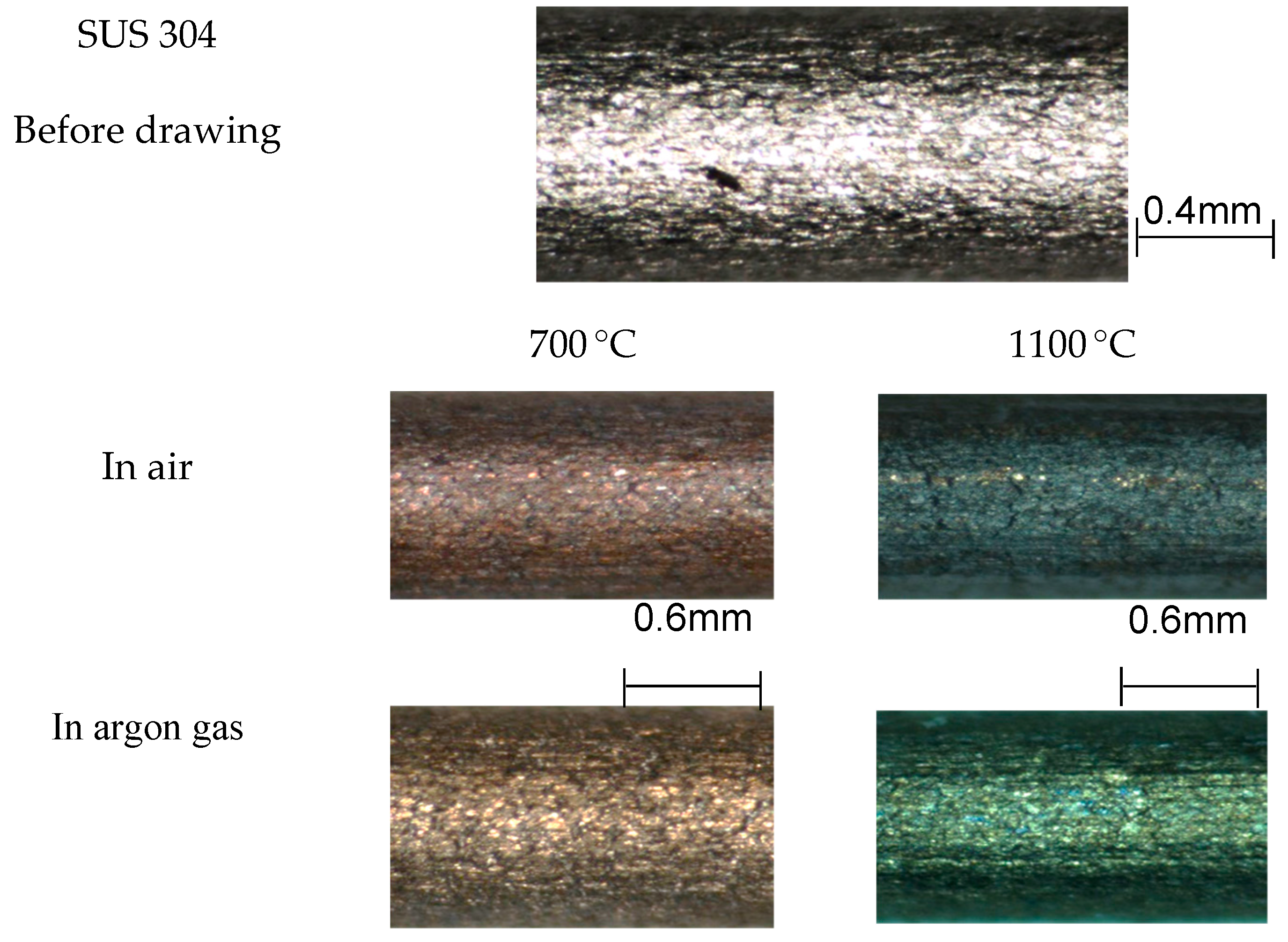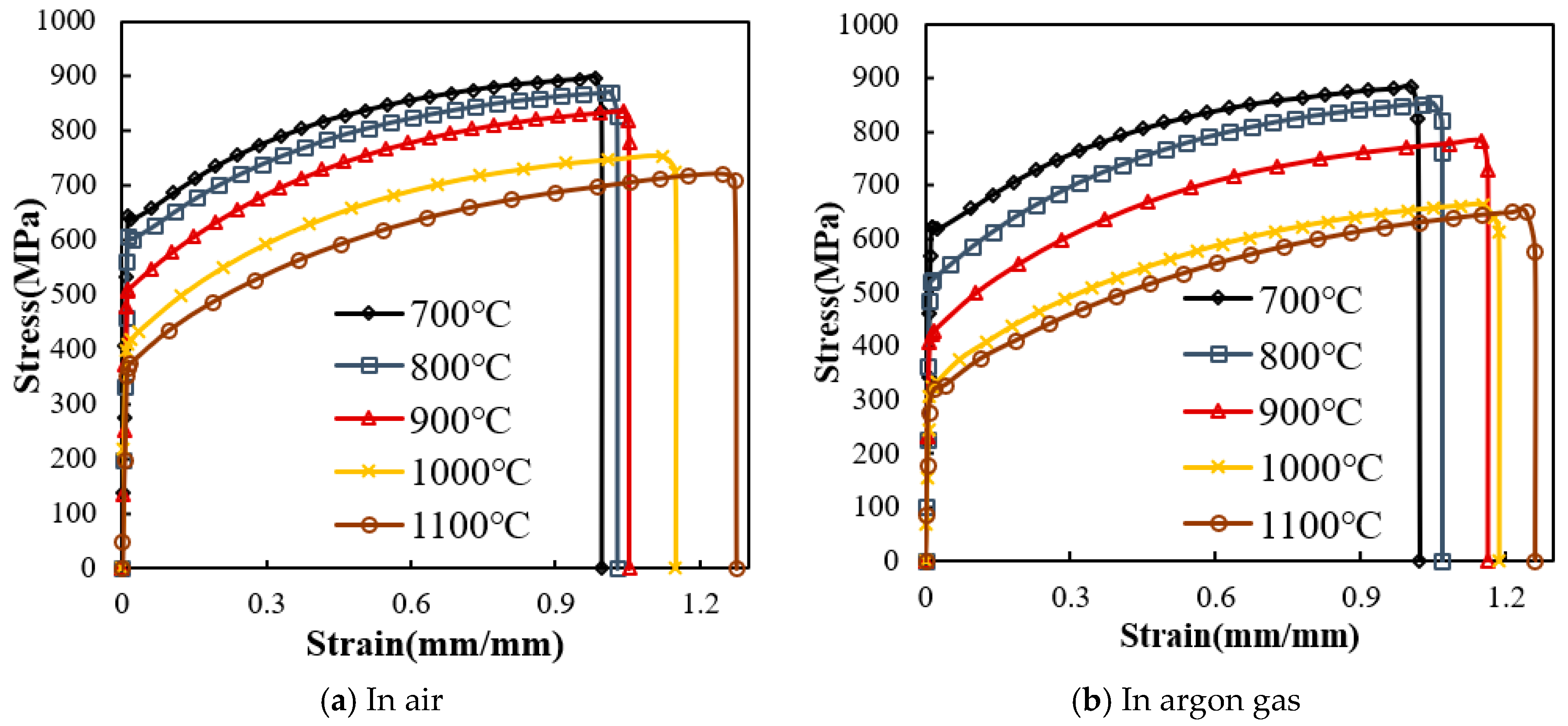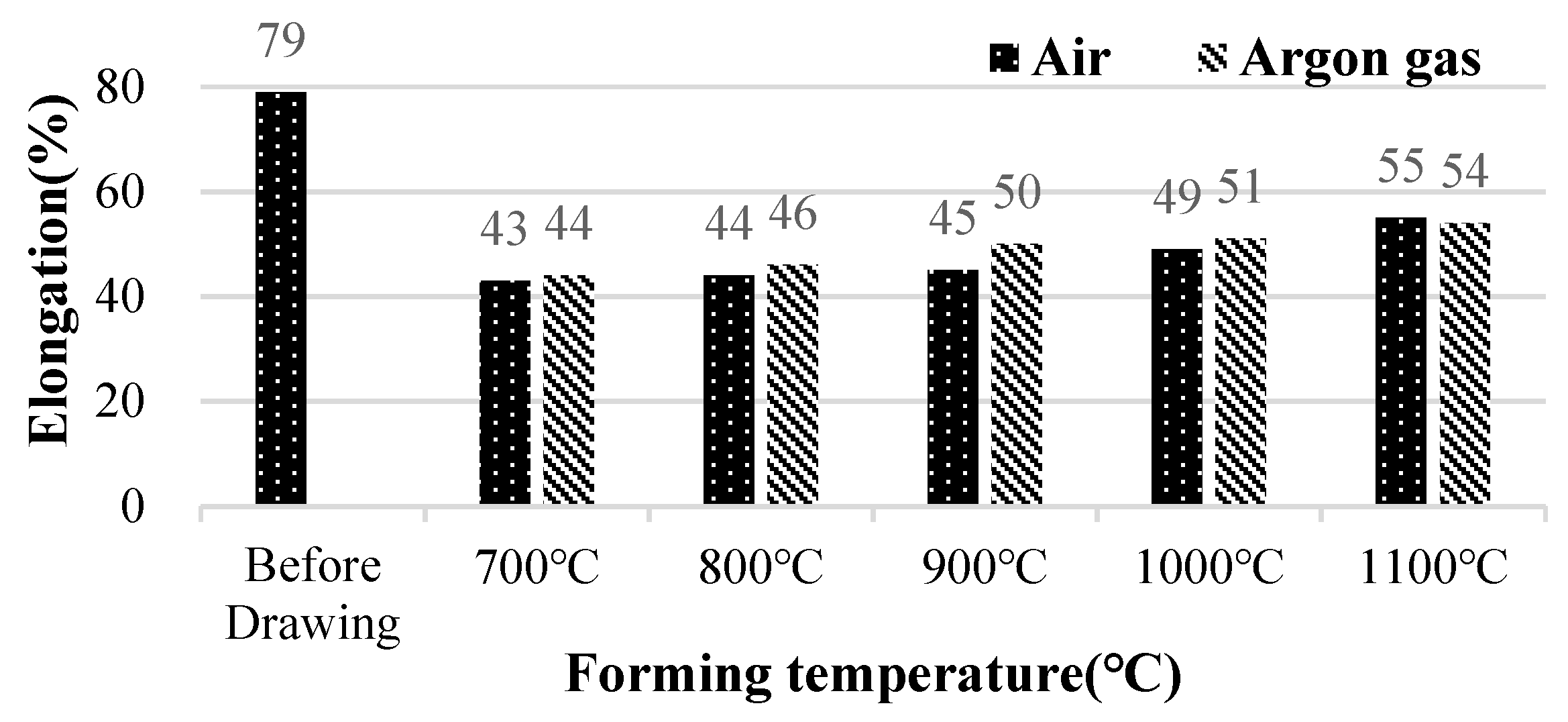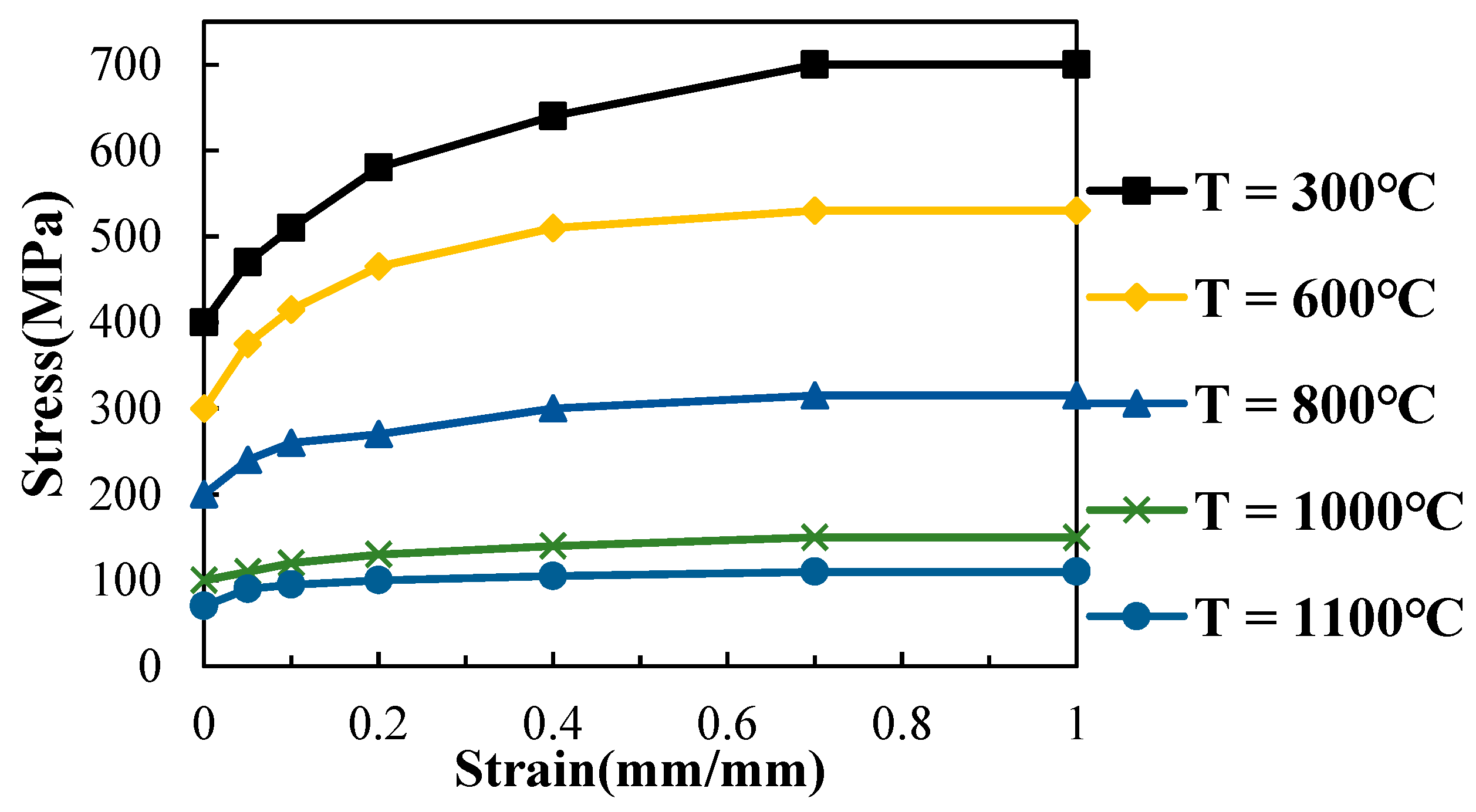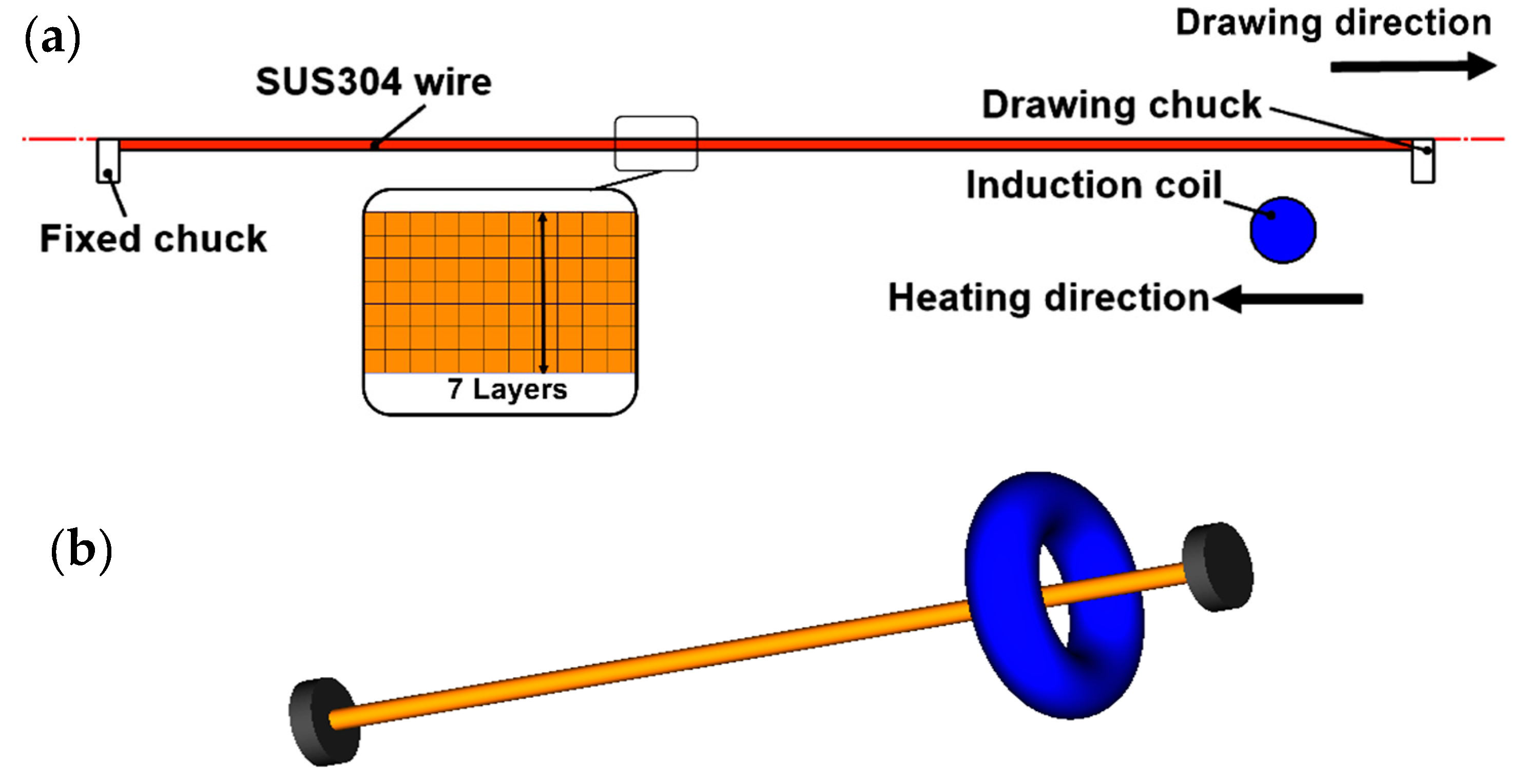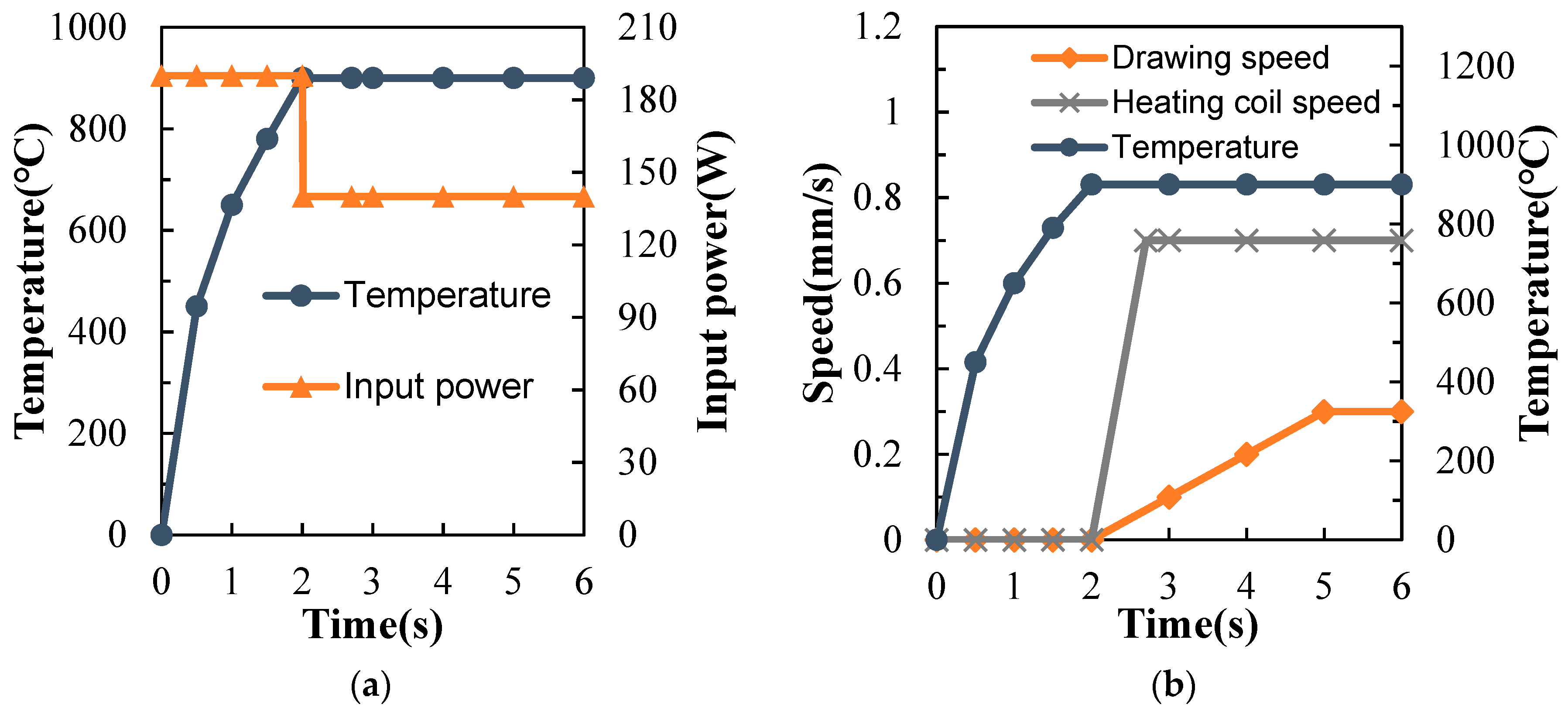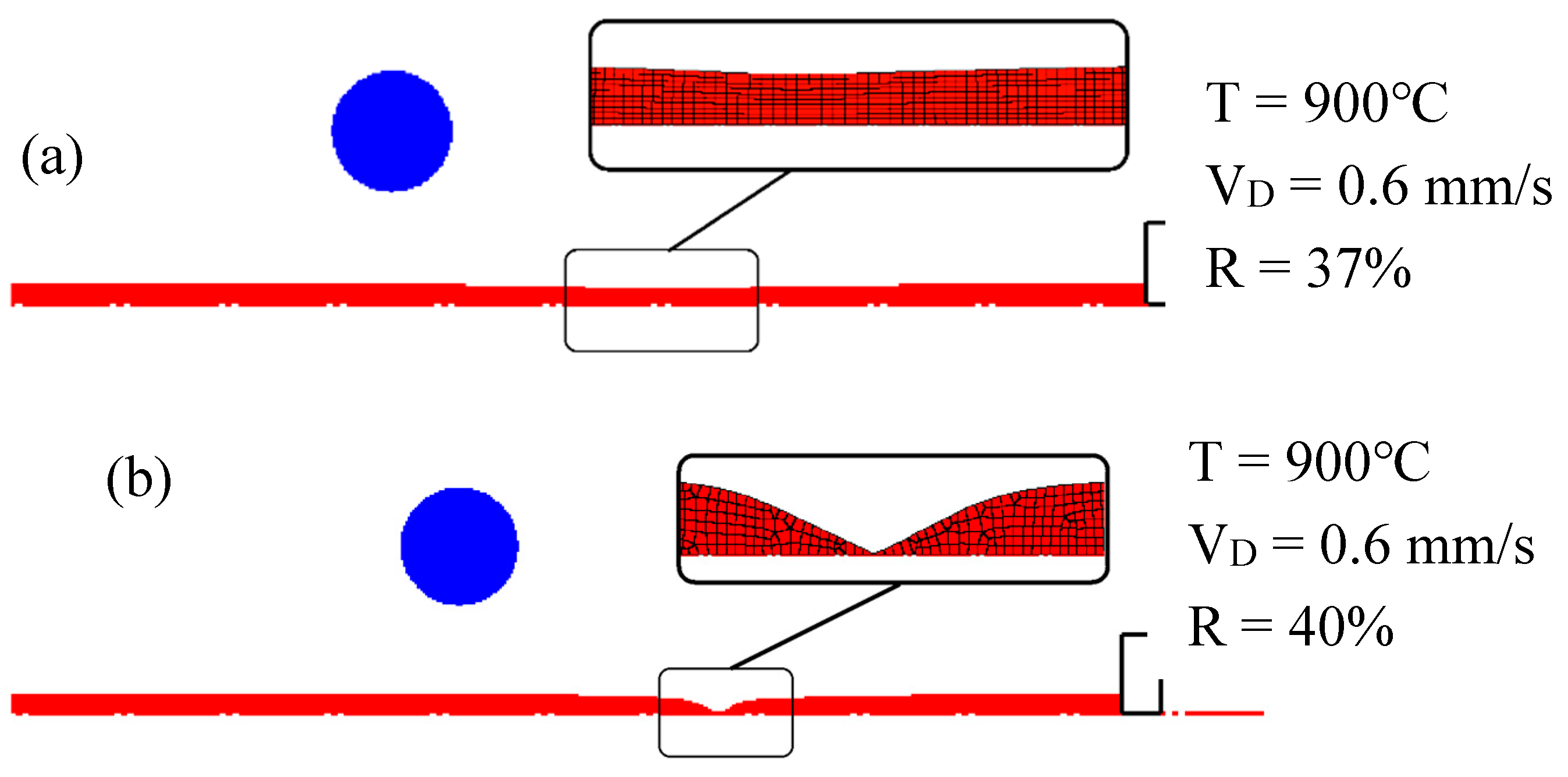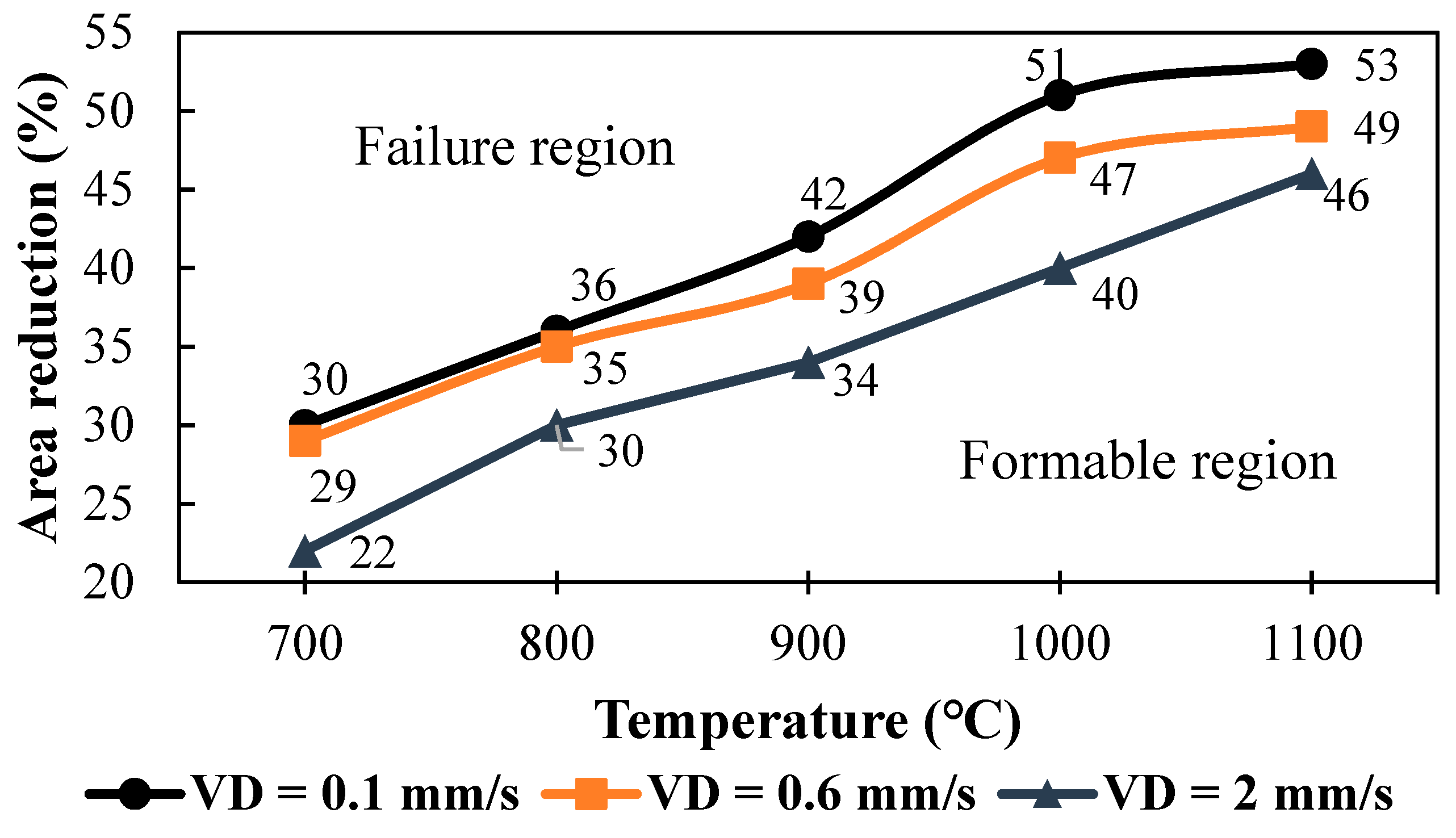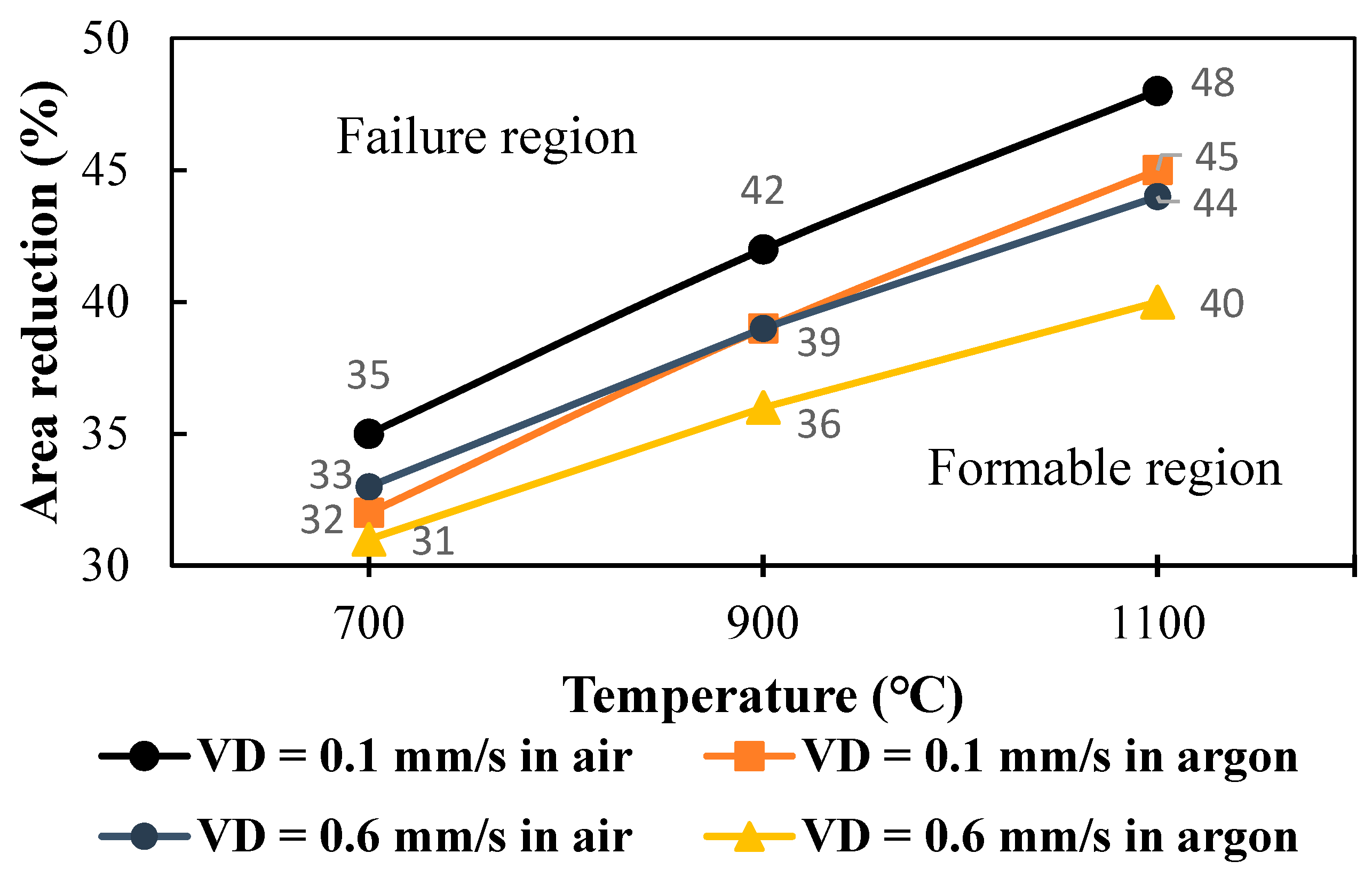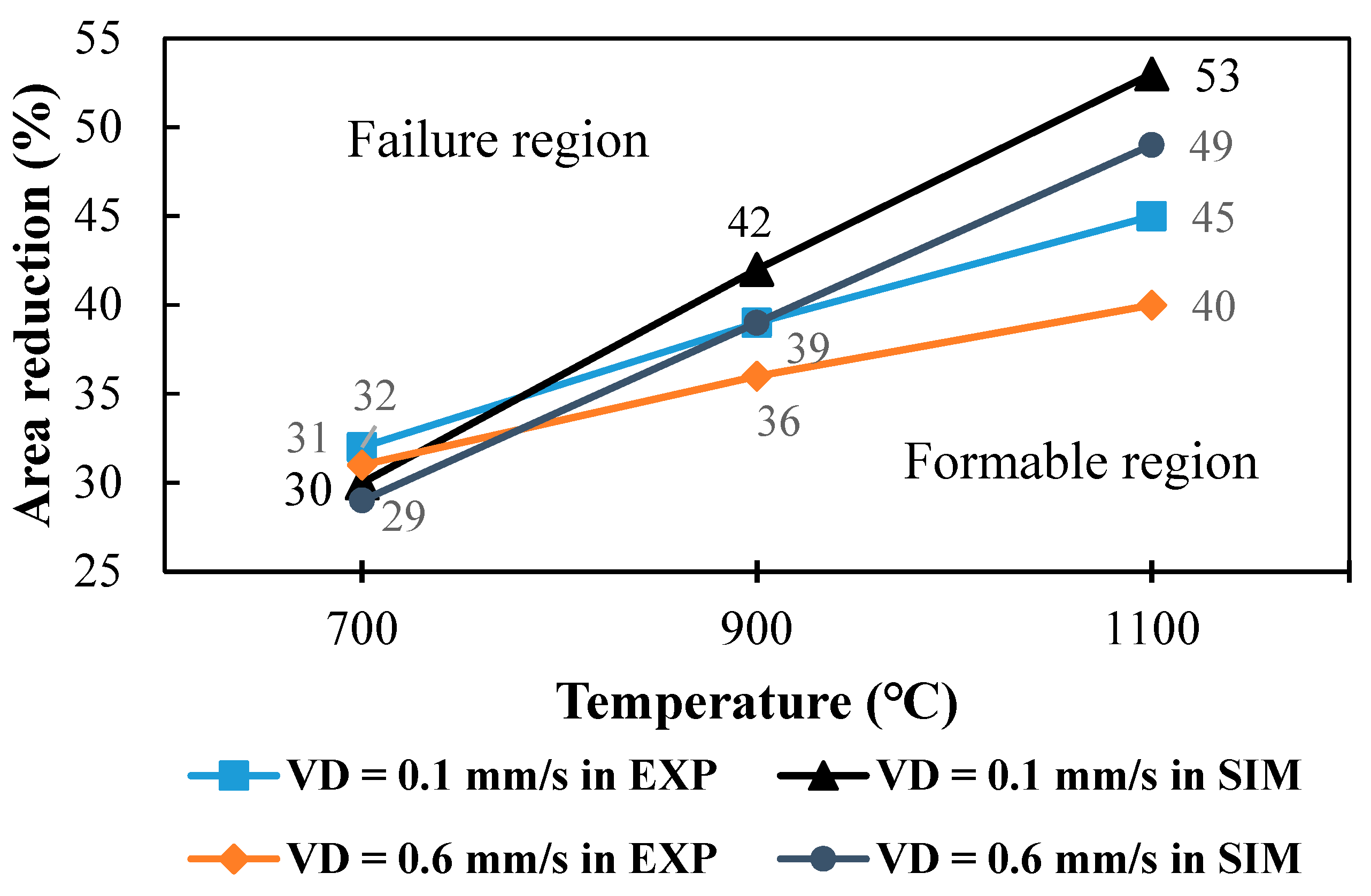1. Introduction
Weiss and Kot first proposed the idea of a dieless drawing process, which can reduce the cross-section of a wire without using a die, in 1969 [
1]. There are no friction or lubrication problems between the workpiece and the die during the process. Compared with the traditional die drawing processes, dieless drawing has some advantages, such as no dies in the process, a larger area reduction at a single pass, no need for special surface treatment of the workpieces, a more flexible process, and so on. Recently, due to prominent development of micro-electro-mechanical-systems (MEMS) and biomedical technology, micro-metal forming has drawn more attention and demand for microtubes and microwires has increased dramatically [
2]. Furushima and Manabe [
3] have successfully manufactured micron-sized tubes of a diameter of 190 μm using dieless drawing processes.
Some research on analytical and experimental modelling in a dieless drawing process has been published. For example, Fortunier et al. [
4] used a simple slice method and divided the wire into three zones to analyze the stability problems during dieless wire drawing processes. Wang et al. [
5] investigated experimentally the wall thickness variation during drawing of stainless steel tube. Tubes with various inner and outer diameters were used and the effects of the area reduction were discussed. Wang et al. [
6] also derived a velocity field and determined the drawing force using a power equivalent method during dieless tube drawing. The drawing force is affected by the width of deformation fields, sectional reduction ratios, deformation temperatures, and the drawing speed. Furushima et al. [
7] proposed a drawing path control method during the drawing process to restrain the unstable deformation. The real deformation limit of the material was investigated by coupling the thermos-mechanical finite element analyses and experiments of the dieless drawing process. Furushima and Manabe [
8] proposed an approach for fabrication of superplastic microtubes using a high-frequency induction heating apparatus and an air-cooling nozzle in a multi-pass dieless drawing process. After four-pass dieless drawing, a microtube with outer and inner diameters of 190 and 91 μm, respectively, was achieved successfully.
Furushima and Manabe [
9] investigated the size effect on the deformation and heat transfer behavior of microtubes during a dieless drawing process using finite element analysis. They found that heat is not conducted from the outside surface to the inside of a macroscale tube in the case of very high-speed drawing. In contrast, due to the size effect at the microscale, the temperature of the outside surface and the inside of microtubes can be increased rapidly. Therefore, high-speed drawing can be realized for microtube dieless drawing. Furushima et al. [
10] investigated the effects of surface roughening and oxidation on the drawing limit in dieless drawing of SUS304 stainless steel microtubes. They found that the limiting area reduction increases to a maximal value and then decreases with heating temperatures in both air and argon gas. The appropriate heating temperatures ranged from 950 to 1100 °C for the maximal drawing limit. Furushima et al. [
11] used a laser irradiated from one direction of a metal microtube to propose a novel rotary laser dieless drawing process. They evaluated the rotating effects on outer diameter variations and outer radius errors in laser dieless drawing of stainless steel SUS304 microtubes. Milenin [
12] used the special features of rheology to propose an approach to reduce the unevenness of the drawn product profile by dividing the drawing process into a few stages. The values of the strains in each stage correspond to the area of intensive hardening on the stress–strain curves of the processed material.
Some research about dieless drawing machines has been reported. For example, Twohig et al. [
13] used a forward non-continuous dieless drawing machine to investigate dieless drawing of a 5 mm-diameter nickel-titanium rod. The effects of different forming parameters on the changes in microstructure were understood through hardness testing and microstructure observation. Naughton and Tiernan [
14] pointed out that the reason that the dieless drawing method has not been fully accepted by the industry is that the forming system is unstable. Data collection and actuation control in the experimental process are the key components when designing and manufacturing the dieless drawing machine. A stability design for a continuous dieless drawing system has been proposed. Tiernan et al. [
15] carried out dieless drawing experiments on AISI O1 steel wires. The experimental results showed that when the speed ratio is greater than 0.5, a large reduction and uniform diameter could be obtained. A load control system was developed to increase the formability of the product and reduce the product diameter tolerance to 0.01–0.05 mm. Supriadi and Manabe [
16] used a visual sensor to monitor the minimum diameter of the deformation zone during dieless drawing to improve the diameter uniformity of the drawn product. The combination of the dieless pumping method and image recognition technology was first presented in their paper.
When the drawn metal is exposed to the atmosphere at a higher temperature, oxidation occurs and an oxide layer is generated on the product surfaces. The oxide layer protecting the inside material may break or crack due to uneven thermal or tensile stresses and lose its protective function. Eventually, the inside material will be oxidized more, which may result in poor surface quality. So far, few works discussed the formation of oxide layers and the effects of the oxide layers on the mechanical properties in dieless drawing of stainless steels. In this study, the formation of oxide layers and their effects on the mechanical properties of the dieless drawn SUS304 wires were investigated. Argon gas was used to surround the drawn wire to prevent the oxidation of the stainless steel during the dieless drawing processes. Tensile tests of stainless steel wires were conducted and the effects of the oxide layer on the mechanical properties are discussed in this paper. Also presented is a series of formability analyses of a wire dieless drawing process using DEFORM software coupled with a high frequency induction mode, which is different to the traditional approach of using a constant temperature zone moving with heating coil position during the drawing process.
Author Contributions
Conceptualization, methodology, research supervision and writing—review and editing were conducted by Y.M.H. Simulation, experiments, validation and writing—original draft preparation were completed by H.H.L.
Funding
The authors would like to extend their thanks to the Ministry of Science and Technology of the Republic of China under Grant no. MOST 107-2221-E-110-038-MY3. The advice and financial support of MOST are gratefully acknowledged.
Acknowledgments
The authors would like to extend their thanks to the ministry of science and technology of the republic of china under grant no. most107-2221-e-110-038-my3. The advice and financial support of most are gratefully acknowledged.
Conflicts of Interest
The authors declare no conflict of interest.
References
- Weiss, V.; Kot, R. Dieless wire drawing with transformation plasticity. Wire J. 1969, 9, 182–189. [Google Scholar]
- Wicht, H.; Bouchaud, J. Nexus Market Analysis for MEMS and Microsystems III. MST News 2009, 5, 33. [Google Scholar]
- Furushima, T.; Manabe, K. Experimental and numerical study on deformation behavior in dieless drawing process of superplastic microtubes. J. Mater. Process. Technol. 2007, 191, 59–63. [Google Scholar] [CrossRef]
- Fortunier, R.; Sassoulas, H.; Momtheillet, F. A thermo-mechanical analysis of stability in dieless wire drawing. Int. J. Mech. Sci. 1997, 39, 615–627. [Google Scholar] [CrossRef]
- Wang, Z.T.; Zhang, S.H.; Xu, Y.; Luan, G.F.; Bai, G.R. Experiment study on the variation of wall thickness during dieless drawing of stainless steel tube. J. Mater. Process. Technol. 2002, 120, 90–93. [Google Scholar] [CrossRef]
- Wang, Z.T.; Luan, G.F.; Bai, G.R. Study of the deformation velocity field and drawing force during the dieless drawing of tube. J. Mater. Process. Technol. 1999, 94, 73–77. [Google Scholar] [CrossRef]
- Furushima, T.; Hirose, S.; Manabe, K. Effective temperature distribution and drawing speed control for stable dieless drawing process metal tube. J. Solid Mech. Mater. Eng. 2009, 3, 236–246. [Google Scholar] [CrossRef]
- Furushima, T.; Manabe, K. Experimental study on multi-pass dieless drawing process of superplastic Zn-22%Al alloy microtubes. J. Mater. Process. Technol. 2007, 187–188, 236–240. [Google Scholar] [CrossRef]
- Furushima, T.; Manabe, K. FE analysis of size effect on deformation and heat transfer behavior in microtube dieless drawing. J. Mater. Process. Technol. 2008, 201, 123–127. [Google Scholar] [CrossRef]
- Furushima, T.; Imagawa, Y.; Manabe, K.; Sakai, T. Effects of oxidation and surface roughening on drawing limit in dieless drawing process of SUS304 stainless steel microtubes. J. Mater. Process. Technol. 2015, 223, 186–192. [Google Scholar] [CrossRef]
- Furushima, T.; Imagawa, Y.; Furushima, S.; Manabe, K. Deformation profile in rotary laser dieless drawing process for metal microtubes. Procedia Eng. 2014, 81, 700–705. [Google Scholar] [CrossRef][Green Version]
- Milenin, A. Rheology-based approach of design the dieless drawing processes. Arch. Civ. Mech. Eng. 2018, 18, 1309–1317. [Google Scholar] [CrossRef]
- Twohig, E.; Tiernan, P.; Tofail, S.A.M. Experimental study on dieless drawing of Nickel-Titanium alloy. J. Mech. Behav. Biomed. Mater. 2012, 8, 8–20. [Google Scholar] [CrossRef] [PubMed]
- Naughton, M.D.; Tiernan, P. Requirements of a dieless wire drawing system. J. Mater. Process. Technol. 2007, 191, 310–313. [Google Scholar] [CrossRef]
- Tiernan, P.; Carolan, R.; Twohig, E.; Tofail, S.A.M. Design and development of a novel load-control dieless rod drawing system. CIRP J. Manuf. Sci. Technol. 2011, 4, 110–117. [Google Scholar] [CrossRef]
- Supriadi, S.; Manabe, K. Enhancement of dimensional accuracy of dieless tube-drawing process with vision-based fuzzy control. J. Mater. Process. Technol. 2013, 213, 905–912. [Google Scholar] [CrossRef]
- Tiernan, P. Dieless drawing of bars, rods, tubes, and wires. Compre. Mater. Process. 2014, 3, 149–157. [Google Scholar]
- Sekiguchi, H.; Kobatake, K.; Osakada, K. A fundamental study on dieless drawing. In Proceedings of the Fifteenth International Machine Tool Design and Research Conference; Tobias, S.A., Koenigsberger, F., Eds.; Palgrave: London, UK, 1975; pp. 539–544. [Google Scholar]
- Hwang, Y.M.; Kuo, T.Y. Dieless drawing of stainless steel tubes. Int. J. Adv. Manuf. Technol. 2013, 68, 1311–1316. [Google Scholar] [CrossRef]
- Qin, F.; Liu, X.F.; Mao, H.E. The thickness distribution of oxidation film on tapered pipe surface in dieless drawing. Inter. J. Corros. 2011, 2011, 615197. [Google Scholar] [CrossRef][Green Version]
Figure 1.
Schematic of a backward non-continuous dieless wire drawing process.
Figure 2.
Layout of self-developed dieless drawing machine.
Figure 3.
Schematic of self-designed argon gas chamber.
Figure 4.
Appearance of stainless steel wire surfaces under different forming conditions.
Figure 5.
Engineering stress-strain curves at different forming temperatures.
Figure 6.
Comparisons of yield stresses of drawn wires in air and argon gas.
Figure 7.
Comparisons of ultimate tensile strength of drawn wires in air and argon gas.
Figure 8.
Comparisons of elongation of drawn wires in air and argon gas.
Figure 9.
Flow stress curves of SUS304 at = 0.25.
Figure 10.
(a) Configuration of wire and heating coil used in DEFORM 2D, (b) 3D perspective view.
Figure 11.
(a) Relationships between forming temperature variation and input power, (b) Relationships between heating speed, forming temperature and drawing speed.
Figure 12.
Profiles of drawn wires at different reductions. (a) Successful case, (b) Failure case.
Figure 13.
Simulative maximal reachable area reductions at different temperatures and drawing speeds.
Figure 14.
Experimental maximal reachable area reductions in air and argon gas.
Figure 15.
Comparisons of maximal reachable area reduction between simulations and experiments.
Table 1.
Forming conditions for dieless wire drawing experiments.
| Parameters | Values |
|---|
| Material | SUS304 |
| Atmosphere | Air, Argon gas |
| Forming temperature, T [°C] | 700, 800, 900, 1000, 1100 |
| Area reduction, R [%] | 30 |
| Drawing speed, VD [mm/s] | 0.6 |
| Heating coil speed, VH [mm/s] | 1.4 |
| Workpiece wire diameter, D0 [mm] | 1 |
| Heating coil loop inner diameter, DC [mm] | 5.5 |
| Heating coil wire diameter, dC [mm] | 3 |
Table 2.
Parameters used in formability analysis.
| Parameters | Values |
|---|
| Diameter of wire, D0 [mm] | 1 |
| Length of wire, WL [mm] | 60 |
| Wire mesh layers in radius, WL | 7 |
| Wire mesh number, WN | 5500 |
| Coil mesh number, CN | 4130 |
| Coil loop inner diameter, DC [mm] | 5.5 |
| Coil wire diameter, dC [mm] | 3 |
| Current frequency, f [KHz] | 1000 |
© 2019 by the authors. Licensee MDPI, Basel, Switzerland. This article is an open access article distributed under the terms and conditions of the Creative Commons Attribution (CC BY) license (http://creativecommons.org/licenses/by/4.0/).
